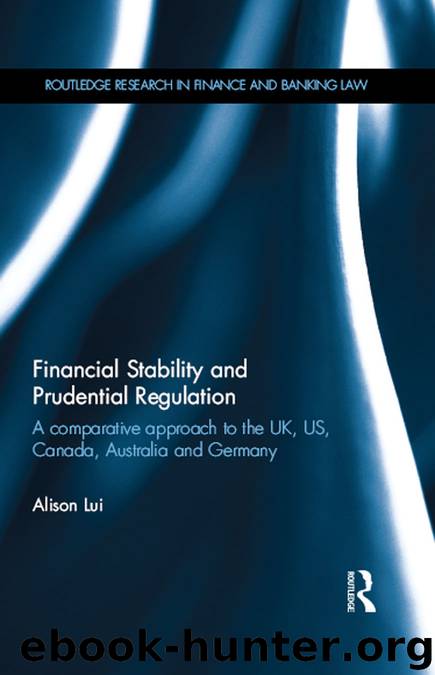Financial Stability and Prudential Regulation by Lui Alison

Author:Lui, Alison
Language: eng
Format: epub
Publisher: Taylor & Francis (CAM)
Consumer protection
In addition to the above monetary-policy and liquidity actions, Geithner (2008) submitted that the Federal Reserve was active in protecting consumers. This is because it worked with various groups in communities across the country to help homeowners identify solutions to avoid foreclosures and their negative effects. This happened too late, though. The Federal Reserve and the other regulators should have cracked down on the explosion of sub-prime mortgages in the first place, although borrowers also played a role. The regulatory structure did not help either. The Federal Reserve had the primary responsibility to protect consumers. However, it was too preoccupied with macro-prudential regulation of banks and the overall economy. Further, the other regulators, such as the OCC and the FDIC, were more concerned with preventing bank failures. Limited supervision of non-bank lending was also a problem (Johnson and Kwak 2010).
Ashcraft and Schuermann (2008) argued that mortgage fraud played a significant role in the sub-prime crisis. Fitch Ratings produced a report in 2007 showing that 45 borrowers defaulted very shortly after origination. Fitch found first-time buyers with questionable income and debts, suspicious items on credit histories and incorrect calculation of debt-to-income ratios. Some lenders were driven by financial rewards and thus became lax with due diligence (Murdoch 2011). Dell’Ariccia et al. (2008) found that the decrease in lending standards led to an increase in the demand for sub-prime loans. Additionally, the lax lending standards were more prevalent in areas where lenders securitised large portions of the originated loans. In some instances, borrowers were encouraged to commit mortgage fraud through ‘liars’ loans’, where they did not need to provide evidence of their income or assets. The regulators failed in protecting consumers since 87 per cent of borrowers could not identify the total cost of loans and 51 per cent could not identify the loan amount from the documents. Mortgages are complex financial documents and these figures indicate that there are weaknesses in consumer disclosure and financial literacy. Ashcraft and Schuermann (2008) also stated that credit-rating agencies made mistakes, both honest and dishonest. Honest mistakes included underestimating the collapse of the housing market and the use of limited data. These mistakes are arguably due to financial innovation and complexity of financial products. Dishonest mistakes were made when credit-rating agencies relied too heavily on arrangers, structuring deals to maximise returns for the arrangers.
Some argue that the US government and legislators made mistakes and failed consumers. Wallison (2011) posits that US housing policy led to the creation of 27 million mortgages, of which half were to default in the sub-prime mortgage crisis. Several academics (Bhutta 2008; Demyanyk and van Hemert 2011) argue that bank lending standards fell after the Community Reinvestment Act 1977 came into force. Much lower deposits amongst lower-income groups and lower underwriting standards in the mortgage industry were common (Demyanyk and van Hemert 2011). The Financial Crisis Inquiry Commission disagreed, stating that US law, especially the Community Reinvestment Act 1977, did not contribute significantly to the sub-prime crisis since many sub-prime lenders were not subject to the Community Reinvestment Act.
Download
This site does not store any files on its server. We only index and link to content provided by other sites. Please contact the content providers to delete copyright contents if any and email us, we'll remove relevant links or contents immediately.
International Integration of the Brazilian Economy by Elias C. Grivoyannis(75479)
The Radium Girls by Kate Moore(11626)
Turbulence by E. J. Noyes(7708)
Nudge - Improving Decisions about Health, Wealth, and Happiness by Thaler Sunstein(7255)
The Black Swan by Nassim Nicholas Taleb(6773)
Rich Dad Poor Dad by Robert T. Kiyosaki(6185)
Pioneering Portfolio Management by David F. Swensen(6083)
Man-made Catastrophes and Risk Information Concealment by Dmitry Chernov & Didier Sornette(5659)
Zero to One by Peter Thiel(5498)
Secrecy World by Jake Bernstein(4393)
Millionaire: The Philanderer, Gambler, and Duelist Who Invented Modern Finance by Janet Gleeson(4106)
The Age of Surveillance Capitalism by Shoshana Zuboff(3991)
Skin in the Game by Nassim Nicholas Taleb(3973)
The Money Culture by Michael Lewis(3851)
Bullshit Jobs by David Graeber(3837)
Skin in the Game: Hidden Asymmetries in Daily Life by Nassim Nicholas Taleb(3731)
The Dhandho Investor by Mohnish Pabrai(3564)
The Wisdom of Finance by Mihir Desai(3529)
Blockchain Basics by Daniel Drescher(3332)
